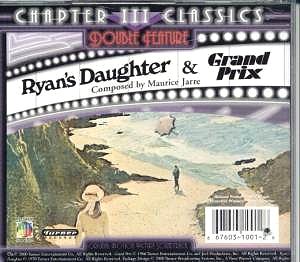Here is real value – the cream of two major Jarre scores on one CD!
Ryan’s Daughter was the third in a series of four collaborations between Jarre and the great director David Lean. Their creative union had begun in 1962 with Lawrence of Arabia and continued with 1965’s Dr Zhivago, Ryan’s Daughter in 1970 and 1984’s A Passage to India. Jarre would receive Academy Awards for three out of four Lean collaborations, with Ryan’s Daughter being the only exception. Which is a pity because Ryan’s Daughter (beautifully photographed in Dingle on the south-west coast of the republic of Ireland) is as good as any of them and arguably better than at least one.
There is a very memorable main theme – a beautiful yearning melody for the dreamy-eyed daughter (Sarah Miles) of the local innkeeper (Leo McKern) who is caught up in divided loyalties between the British Crown and the Irish revolutionaries (it is set around the time of the 1916 uprising). She escapes from the loveless marriage to the well-meaning but unromantic local schoolmaster (Robert Mitchum) into the arms of the British officer commanding the nearby garrison. Highlights of this score include; the weirdly evocative music presented on some very unusual percussion instruments for the shambling gait of Michael the crippled village idiot (an incredible performance by John Mills – who is not credited in the liner notes!); the shell shock of the officer (Christopher Jones) in ‘The Shake’ and the defiantly exuberant march of the Irish rebels.
John Frankenheimer’s Grand Prix (1966) tells the story of the tumultuous lives and loves of four motor racing drivers as they dice with death, speeding across the race tracks of the world. Again, the music demonstrates Jarre’s ability to deliver a major theme that lingers in the memory (a sort of victors’ march – muscular, heroic, triumphant) and his gift to evoke situations and atmosphere. Here his harmonies and orchestrations uncannily suggest speeding cars and screaming wheels. Balancing all the action cues (in one case with motor racing sound effects) are more idyllic and romantic cues for the drivers’ love lives. Much use is made of Latin rhythms to lend an air of international glamour and sophistication to the score.
Highly recommended .
Ian Lace


